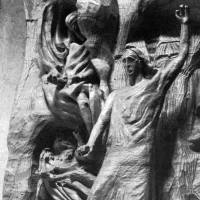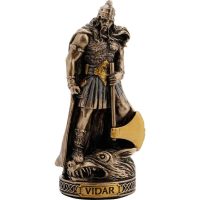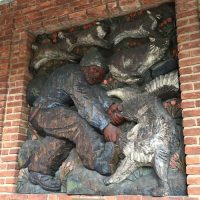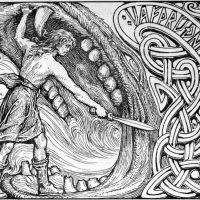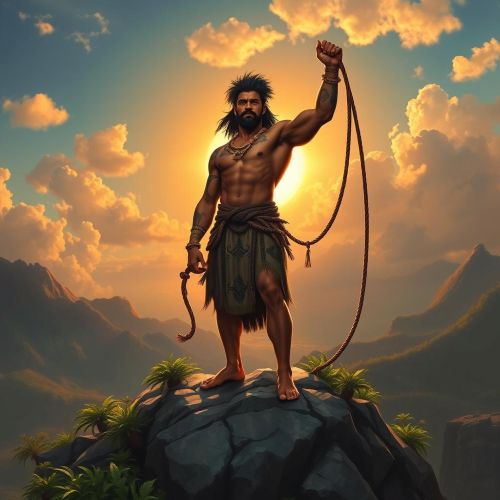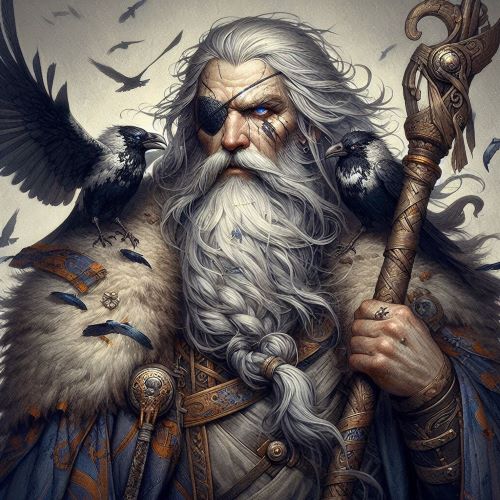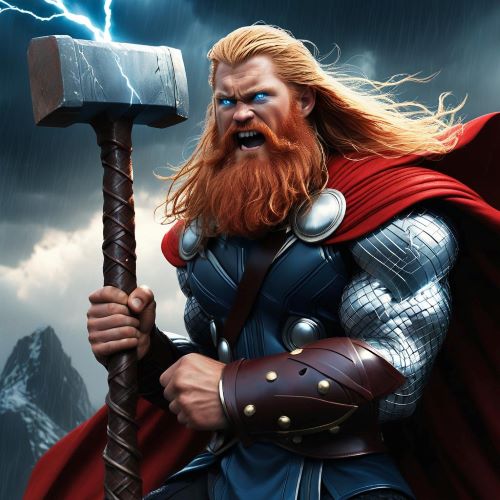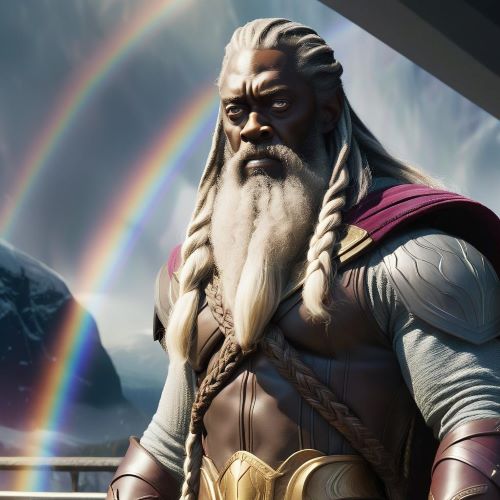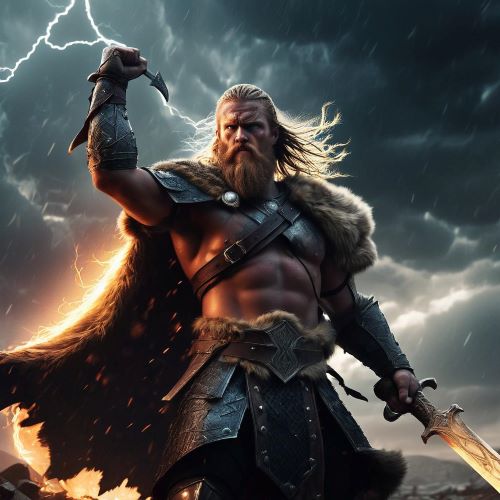Vidar : The Silent God
Listen
At a glance
| Description | |
|---|---|
| Origin | Norse Mythology |
| Classification | Gods |
| Family Members | Odin (Father), Grid (Mother) |
| Region | Iceland, Norway, Denmark, Finland |
| Associated With | Strength, Silence, Justice |
Vidar
Introduction
In the vast landscape of Norse mythology, amidst the tumultuous clashes between gods and giants, lies a figure of profound significance: Vidar, the steadfast son of Odin. Often portrayed as the silent avenger, Vidar embodies qualities of resilience, determination, and an unwavering spirit that confronts the chaos of Ragnarok. Standing apart from his more flamboyant brother Thor, Vidar plays a pivotal role in the cataclysmic events of Ragnarok, the foretold apocalypse. Known by various epithets, including the Silent God of Vengeance, Vidar’s presence in the Norse pantheon is unmistakable. As one of Odin’s sons, he is revered for his quiet strength and resilience, symbolizing concepts of vengeance, justice, and the enduring spirit of the Norse people.
Physical Traits
Vidar’s portrayal often emphasizes his towering stature and formidable physique, mirroring the strength inherent in Norse deities. Notably, he is depicted wearing a distinctive boot crafted from discarded leather scraps, a detail of significance in the events of Ragnarok. Unlike many figures in Norse mythology, Vidar’s physical features are not extensively described. The Prose Edda, a primary source for Norse myths, simply labels him as the “silent god” donning “thick shoes”. This lack of detailed description has inspired diverse artistic interpretations, ranging from depictions of a stoic and mighty warrior to representations highlighting his affinity with nature and the wild.
Family
Born of illustrious lineage, Vidar is the offspring of Odin, the esteemed Allfather, and Grid, a goddess whose name often resides in the shadow of more prominent figures. Despite his relative obscurity compared to Odin and his brethren, Vidar’s familial connections intricately weave him into the fabric of Norse mythology. Among his kin are Thor, the thunderous wielder of Mjolnir, and Baldr, the radiant god of light, forging bonds that interlace the fates of gods and mortals alike. Vidar’s heritage marks him as both an insider and an outsider in the realm of the Aesir. His father Odin, revered as the chief deity, stands in stark contrast to his mother, Grid, a giantess from the Jötnar lineage, often viewed as adversaries to the gods.
This mixed parentage imbues Vidar with potential for great strength and an inherent sense of detachment from the inner circle of the Aesir. Amidst his half-brothers, who encompass the thunderous Thor, the cunning Loki, and the vengeful Höðr, Vidar maintains a solitary demeanor, often retreating to the solitude of his wooded domain rather than the bustling halls of Asgard. Additionally, Vidar shares a mysterious connection with Váli, another of Odin’s sons, whose role in the events of Ragnarök intertwines with Vidar’s own, hinting at a deeper bond rooted in themes of vengeance and divine retribution.
Other names
In the rich tapestry of Norse lore, Vidar is adorned with various epithets and aliases, each a reflection of distinct facets of his character and significance within the divine hierarchy. Among these, he is often hailed as the “Silent God” or the “Avenger of the Gods,” underscoring his stoic demeanor and pivotal role in exacting retribution for his father’s demise during Ragnarok, the cataclysmic twilight of Norse mythology. While “Vidar” serves as the prevalent anglicized rendition of his name, its Old Norse counterpart, “Víðarr,” suggests connotations of expansive rule or far-reaching influence.
This title hints at a dominion extending beyond the immediate confines of godly realms. Less prevalent alternatives such as Vithar and Vitharr further diversify the lexicon associated with him. Beyond his guise as “The Silent God,” Vidar is also enshrined with several other epithets in the annals of Norse mythology. Among these, “The Wide-Ruling One” bespeaks his divine authority, while “The Avenger” intimates his pivotal role in seeking justice for his father’s fate amid the tumult of Ragnarok.
Powers and Abilities
While Vidar may not wield thunder like his illustrious brother Thor or possess the sagacity of Odin, he boasts unique powers and abilities that distinguish him among the Norse pantheon. Foremost among these is his unmatched strength and resilience, enabling him to confront even the most formidable adversaries with unwavering fortitude. Legends speak of his mastery in combat, wielding celestial-forged weapons with unparalleled skill and precision. Yet, it is Vidar’s role as the silent avenger that truly encapsulates his essence, as he stands as a stalwart guardian against the encroaching chaos threatening to engulf the world.
Renowned for his extraordinary might, Vidar’s most celebrated feat lies in his pivotal role during Ragnarok, the cataclysmic end of days in Norse mythology. Here, he avenges his father Odin’s demise by confronting the monstrous wolf Fenrir in a climactic showdown. Utilizing his colossal boot, Vidar steps upon Fenrir’s lower jaw, seizing the leverage to rend the beast’s jaws asunder. Although detailed descriptions of Vidar’s abilities are scarce, the Prose Edda affirms his status as one of the mightiest gods, nearly rivaling the formidable Thor in sheer physical prowess.
Adding to his enigmatic allure is Vidar’s association with silence, earning him the epithet of the “silent god.” The rationale behind this moniker remains shrouded in mystery, with interpretations ranging from a reflection of his contemplative nature to symbolizing the inevitability of his actions, particularly during the tumultuous events of Ragnarok. Additionally, Vidar’s distinct footwear, described as a “thick shoe” in the Prose Edda, offers further intrigue. Some scholars posit that this detail underscores his pragmatic and grounded demeanor, symbolizing the importance of preparation and resilience, traits indispensable in confronting the cataclysmic upheaval of Ragnarok.
Central to Vidar’s narrative is his defining moment during Ragnarok, where he confronts Fenrir in a climactic battle for the fate of the cosmos. As the monstrous wolf threatens to devour Odin, Vidar emerges as a beacon of defiance, intervening to avenge his father’s impending demise. With unyielding strength, Vidar employs his mighty boot to pin Fenrir’s jaws shut, before delivering the fatal blow that seals the beast’s fate and avenges Odin’s death.
This act of vengeance holds profound significance, symbolizing defiance against the inexorable march of fate. While Ragnarok heralds the demise of the old world, Vidar’s triumph over Fenrir offers a glimmer of hope for the dawn of a new era. In some retellings, Vidar, alongside select gods, survives the cataclysm, heralding the dawn of a rejuvenated world, testament to his enduring legacy as a guardian of divine justice and resilience in the face of annihilation.
Modern Day Influence
Vidar’s enduring impact permeates modern culture across diverse mediums, from literature to video games, captivating audiences with his tale of silent strength and resilience. While Norse mythology may not hold sway as a dominant religion in contemporary society, the figure of Vidar continues to resonate, his narrative offering timeless lessons in fortitude and retribution.
In the realm of entertainment, Vidar’s character finds vivid expression in various forms of media. Comic books, particularly those exploring Norse mythological themes, depict him as a formidable and unyielding warrior, embodying the essence of stoic resolve. Video games have likewise embraced Vidar’s presence, often featuring him as a playable character, showcasing his prowess and connection to the natural world.
Yet, Vidar’s influence extends beyond mere entertainment, transcending into the realm of symbolic interpretation. The symbolism of Vidar’s “thick shoe” has sparked modern reimaginings, serving as a poignant metaphor for preparedness and resilience in the face of adversity. This resonates deeply with contemporary audiences, underscoring the value of fortitude and the capacity to surmount life’s challenges with unwavering resolve.
Related Images
Frequently Asked Questions
What is lorem Ipsum?
I am text block. Click edit button to change this text. Lorem ipsum dolor sit amet, consectetur adipiscing elit. Ut elit tellus, luctus nec ullamcorper mattis, pulvinar dapibus leo.
What is lorem Ipsum?
I am text block. Click edit button to change this text. Lorem ipsum dolor sit amet, consectetur adipiscing elit. Ut elit tellus, luctus nec ullamcorper mattis, pulvinar dapibus leo.
What is lorem Ipsum?
I am text block. Click edit button to change this text. Lorem ipsum dolor sit amet, consectetur adipiscing elit. Ut elit tellus, luctus nec ullamcorper mattis, pulvinar dapibus leo.
What is lorem Ipsum?
I am text block. Click edit button to change this text. Lorem ipsum dolor sit amet, consectetur adipiscing elit. Ut elit tellus, luctus nec ullamcorper mattis, pulvinar dapibus leo.
What is lorem Ipsum?
I am text block. Click edit button to change this text. Lorem ipsum dolor sit amet, consectetur adipiscing elit. Ut elit tellus, luctus nec ullamcorper mattis, pulvinar dapibus leo.


